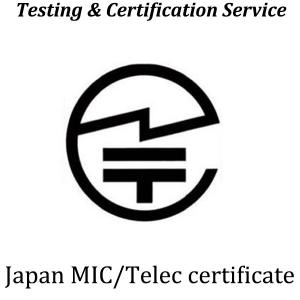

Add to Cart
Introduction of Japanese TELEC certification
Japan ’s certification for radio frequency equipment is called
Radio Equipment Type Approval. The official regulatory agency is
Japan ’s Ministry of Internal Affairs and Communications (MIC). The
main certification body is TELEC (Telecom Engineering Center)
designated by MIC. / JQA / SGS / ITS / TUV / UL has a total of 12
certification agencies, so it is also commonly known as TELEC
certification, also known as MIC certification, RF certification,
GITEKI certification, technology adaptation certification, similar
to domestic SRRC certification.
TELEC certification complies with the Radio Law of Japan, and the specific test specifications are in compliance with MIC (Ministry of Internal Affairs and Communications) Notice No. 88 regulations. According to the requirements of the Japanese Radio Law, the production, sale, and operation of wireless equipment in Japan must comply with the technical regulations approved by the MIC, and it is mandatory to apply for a type approval certificate for radio equipment (ie, TELEC certification).
Basic information of TELEC certification
Whether mandatory: compulsory certification
Factory inspection requirements: No requirements, but ISO
certificates or recognized quality control documents are required
Certificate holder requirements: no requirements
Certificate validity: None
Certification cycle: about 4 weeks
Technical information: voltage frequency AC 100V / 200V, 50Hz /
60Hz, plug JIS 8303
Explanation of TELEC certification, GITEKI certification, MIC
certification and MARK technical certification
· TELEC certification and GITEKI certification
The full name of Japan ’s TELEC is TELECom Engineering Center. It
is a certification agency for the Radio Law approved by the
Ministry of Internal Affairs and Communications. In 2014, TELEC
also obtained the certification of the Electrical Communications
Business Law. Now, in general terms, TELEC certification is
equivalent to GITEKI certification .
TELEC certification and MIC certification
The Ministry of Internal Affairs and Communications of Japan is
referred to as MIC, and its English name is Ministry of Internal
Affairs and Communications. The Ministry of Internal Affairs and
Communications is the regulatory agency of Japan's Radio Law and
Electrical Communications Business Law. In general, MIC
certification is equivalent to TELEC certification.
TELEC certification and MARK technology certification
After passing the TELEC certification, the product can be printed
with the GITEKI logo. GITEKI is derived from the Japanese name for
certification: "Technical マ ー ク", the Japanese word Giroki spelling
GITEKI, so GITEKI certification is also known as GITEKI
certification, Technical fitness certification is just a different
name.
Certification classification
TELEC certification includes Test Certification and Type
Certification. Test certification is verification for each
equipment unit, and the certification is valid only for each
verified equipment unit;
Type certification refers to the verification of samples of a batch
of equipment that is also designed and manufactured. The
certification is valid for the batch of equipment, but if the
design or manufacturing of the equipment changes, the equipment
will need to be recertified.
It is worth noting that the use of non-low-power radio stations and
their terminal equipment requires a license from the MIC. In
addition, there are two cases for the compliance certification of
telecommunication terminal equipment:
· For ordinary telephone devices, JATE certification is required as
required by the Telecommunications Business Law;
· For wireless terminal equipment, in addition to JATE
certification required by the Telecommunications Business Law,
TELEC certification is required according to the Radio Law.
Applicable product range
TELEC certification for wireless RF products includes: Bluetooth
products, ZigBee products, telemeters, WiFi products, wireless
microphones, pagers, LTE · RFID (2.4GHz, 920MHz) products, UWB
radio systems, GSM products, etc.
Application process
1. Fill in the application form, prepare materials and samples
2.The inspection agency reviews the data and initially tests the
samples
3.The testing agency formally applies to the agency accredited by
the MIC of the General Affairs Department.
4. Institutional review documents
5. Sample test, provide test report (can be tested by authorized
laboratory)
6. After the documents and test reports are passed, the Japanese
MIC issues a certificate
Application materials
1.Technical model specification table
2.Quality Management System Statement
3.Quality control confirmation method or manufacturer's ISO 9001
certificate
4.Confirmation Letter of Construction Guarantee
5.Rated power statement
6.Antenna report
7.Test report including test results, test setup photos and
inspections performed)
(8.Block diagram, schematic diagram, bill of materials, parts
placement, IC data sheet, internal and external photos, product
description, user manual, operation / technical description,
accessories description)
9.Label information (label position, label content)
10. If you act as an agent or authorized representative, the
manufacturer also needs a letter of attorney / authorization letter
